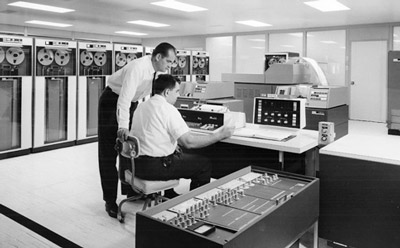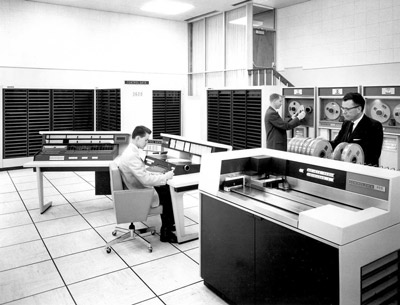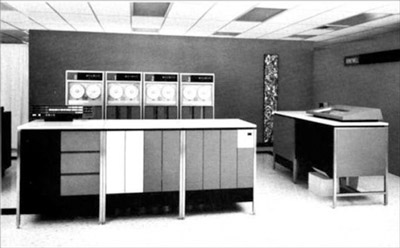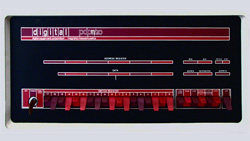Craig Jensen
50 YEARS AND A BILLION SATISFIED USERS
This month (September 2018) marks Craig’s 50th year in the computer industry. He wrote his first computer programs in the Fortran IV language while a student at Northeastern University, and left within a few months to start a career as a professional computer software designer. Within two years, he was the head of a corporate computer research department and teaching a course in computer systems design at a local college. The rest, as they say, is history, and you can follow his path below.
While it is true that I got into the field at the right time and made a heckuva lot of money at it, the most gratifying result is how many people have used my software and patented technologies to their benefit. The number now exceeds one billion users. – CJ
EXECUTIVE FOR A DAY
In 1967, Craig was selected by his high school to participate in a business education program called “Telephone Executive Leader For A Day” (TELFAD). He spent a day shadowing the CEO of New England Telephone Company in Quincy, Massachusetts.
Two top students were selected, one male and one female. I was assigned to shadow the CEO and learn what it was like to be an executive. The other student, a very intelligent and capable young woman, was not given an executive assignment, but was assigned to be a secretary – just because she was a female! And, in those days, no one thought that was odd or unfair. – CJ
While touring the company, I heard a loud ripping sound. It was a computer printer, called a ‘chain printer.’ Its print hammers were hitting the paper so fast that it sounded like cloth being torn apart. The paper was flying through the air out the back of the printer where it was caught in a wire cage. The printer grabbed my interest, and so did the computer it was attached to it: an IBM 7070. – CJ

IBM 7070 – 0.028MHz CPU with 50,000 bytes of memory
[© IBM]
FIVE SECONDS A WEEK
In high school, Craig was recruited by numerous universities, including Northeastern, which he selected for its Engineering program and its work/study approach. It was there, in 1968, that Craig programmed a computer for the first time: a Control Data 3600 mainframe computer, programming it in FORTRAN IV to solve physics problems.
As a freshman, I was allocated only five seconds of computer time per week. I tried hard to write code that would consume the entire five seconds, but I didn’t even come close. The mind-boggling speed of the machine pulled me right in and I became entranced with computers for life. – CJ

Control Data 3600 – 0.483MHz CPU with 1.5MB memory[The Charles Babbage Institute, University of Minnesota]
SHIFTING SHIFTS
Faced with the overwhelming pressures of both a full-time college schedule and a full-time night job, Craig transferred from the day school to the part-time night program at Northeastern and from the night shift to the day shift at Western Electric, where he worked refurbishing telephones.
In the Western Electric factory, Craig more than once applied his engineering skills to demonstrate to management how to greatly increase worker productivity, but management reacted to his recommendations with alarm out of fear of that these changes would rile union leaders.
That’s when I first saw how a lack of good organization reduced efficiency and caused disharmony. It wasn’t just a ‘management-labor relations’ problem, but a ‘can’t get anything done’ problem. – CJ
When the company found out I was in college, they told me I had to transfer off the assembly line to a white collar job. They offered me the choice of becoming a bookkeeper or a computer operator for a Honeywell 200 computer system. I thought about it for a millisecond or two and began my career in computers. – CJ

Honeywell 200 Computer – 0.5Mhz CPU and 32K bytes of memory[Photo courtesy of Honeywell]
TRIAL BY FIRE
In 1972, Craig was at Applied Data Research (ADR) in Princeton, NJ, working as an apprentice on the design of the first virtual memory operating system for DEC’s PDP-11 computer. When the lead designer left suddenly for academia, Craig took over and completed the design himself.
This ‘trial by fire’ increased his confidence in his programming abilities and by the end of the project he had become knowledgeable in the innermost workings of computer operating systems. As a result he found himself in demand by other computer companies who wanted such a system for their own product lines.
The OS worked like a charm and I was wooed away by Data General with the enticement of a car and stock options to design a similar system for a new computer DG was working on. At 22, I was on top of the world. – CJ
Unfortunately, Craig was unable to convince the other engineers at Data General that his design was feasible, even though he had already implemented it successfully at ADR. The project was canceled his first day on the job.
I was devastated that the other engineers pooh-poohed my design. I crashed from the top of the world to the depths of frustration in a single day. I then spent six months doing busywork (nothing important, really) and then was introduced to Scientology by a coworker. In a three-day Scientology course, I discovered that my interpersonal communication skills were terrible, and I fixed them using the tools learned from the course. Immediately, my projects started getting approved and within another six months I was implementing my operating system for Data General – their first virtual memory operating system. – CJ
GEEK ZONE
In 1974, Craig met Sally, his future wife and partner in creating Executive Software, which was later renamed Diskeeper Corporation and then, in 2012, Condusiv Technologies Corporation.
Talk about being in the geek zone – For our first date, I took her to the computer lab at Data General, where I thought I was entertaining her by letting her watch me write code. Somehow, the relationship survived. – CJ
A CONTRACT PROGRAMMER
From 1976 to 1986, Craig worked as a contract programmer and doing volunteer work for his church. At the same time, he spent nights and weekends creating his own software products.
As a contractor, I loved the fact that I could work on wildly different types of software. Some of my contracts included a truck cargo tracking system for the Apple II, a word processor for the PDP -11, and a shopping mall profit forecasting system for the DECsystem-10. On the side, I created such products as a Lunar Lander game for the Apple II, a music composing tool, also for the Apple II, and a corporate e-mail system for PDP-11 and VAX computers. – CJ
DON’T QUIT YOUR DAY JOB
Craig founded Executive Software in March of 1981. In 1982, he made the mistake of stopping all outside contracts to work full time on developing a product of his own. It nearly bankrupted him.
I was developing an electronic mail product for PDP-11 and VAX. I had a PDP-11/20 in a refrigerator-sized equipment rack in a spare bedroom at home. I’d get up in the morning and start coding. My wife would bring me food as I coded through the day and long into the night. Weekends, too. This went on for months. – CJ
To pay the bills, he resumed his contract programming, devoting only spare time to his own product.

VT-100 monitor [© Dave Fischer, GNUFDL]

DEC PDP-11/20
AUTHOR
During this period, Craig also conducted free computer programming classes in his home, then wrote a book on the subject: The Craft of Computer Programming, published by Warner Books in 1985. The book sold out its first printing. Its third edition can now be found free online at http://www.craftof.com/.
My book was accepted by Warner Books and published in April 1985. When the first edition sold out, they declined to reprint it, explaining that computer books were ‘just a passing fad.’ – CJ
SET IT AND FORGET IT
Executive Software’s first product was an electronic mail system called EXECmail. It was used by Xerox and the US Naval Reserve, among others, but it didn’t take off as Craig had expected.
Switching his focus to market research, Craig found that the biggest problem that managers of large, corporate computer systems were experiencing was fragmentation, a condition in which the files of data stored in a computer became split into pieces and scattered around inside the computer. Fragmentation was causing such severe problems with computers that many system managers were forced to spend nights and weekends hard at work putting computer data files back together. Craig recruited another programmer and the two of them developed a program to do all that automatically. It was called Diskeeper.®
Released in November, 1986, to an overwhelming public reception, Diskeeper put Executive Software on the map. In just a few years, the company’s annual income increased from USD $400,000 to over USD $10 million; staff were hired at a rapid rate; and the organization was expanding so fast it had to move to larger quarters every year. Executive Software’s rapid expansion earned it a place on Inc. Magazine’s list of the 500 fastest growing private companies in the United States for four years in a row.
Frankly, the huge success of Diskeeper surprised me. In retrospect, however, it was obvious: the six other defragmenters introduced around the same time were just tapeless versions of the same old backup-and-restore headache. I had made Diskeeper a “set it and forget it” product because that’s exactly what customers told us they wanted. – CJ
DISKEEPER BECOMES A HOUSEHOLD WORD
On April 10, 2002, Craig and Diskeeper enjoyed 15 seconds of TV game-show fame when a word he coined in 1986 was used on the TV show Jeopardy with the answer: “Diskeeper is software to do this, reorganize your computer’s files.” The contestant won $2,000 by correctly providing the question, “What is defragment?”
GROWTH AND TRANSITION
The company continued to grow. In fact, it has been profitable every year since its inception. In 2005, the company changed its name from Executive Software to Diskeeper Corporation.
In 2008, Craig turned over CEO responsibilities but retained his roles as Chairman of the Board and Chief Software Architect. Since then he has focused on opening up international markets and developing new product lines.
In 2012, the company changed its name again to Condusiv Technologies. This change reflects the company’s expansion into broader areas of computer performance, including faster boot times, solid state drive performance and performance of virtualized systems.
SOLID STATE DRIVES – SSDs
For the past several years, Craig has been guiding his company’s R & D effort in the development of proprietary technologies, including Intelligent File Access Acceleration Sequencing Technology (“I-FAAST”®) to make storage devices perform faster than their rated speeds; ExpressCache,® technology that helps SSD-based and hybrid systems deliver on the promise of faster, more reliable and longer lasting storage; IntelliWrite,® to prevent fragmentation from ocurring in the first place; HyperBoot,® to make Windows computers boot up in 30 seconds or less; and the disruptive technology trademarked as InvisiTasking® that reduces system overhead quite literally to zero for scanning processes such as backup, antivirus and, of course, defragmentation. With the licensing of these technologies to other companies, Condusiv officially extended beyond the defragmentation market and into the storage performance market, beginning a whole new era of expansion and success for the company.
Initially, I was worried that SSDs might make defragmentation irrelevant because SSDs would be so much faster than rotating disk drives. But I was stunned when the test results in our labs showed that SSD performance was nowhere near expectations and insufficient to justify the extra cost of these devices. SSDs also brought a raft of new problems to the storage performance realm. Overcoming these was some of the most challenging programming work we’ve ever done. I loved it! In the end we were able to help SSD manufacturers make the devices live up to the promise of high speed, high reliability and long life. – CJ
ASIA
In May 2008, the company opened an Asian office to serve South Korea and the Greater China market (the People’s Republic of China, Hong Kong SAR and Taiwan). It got off to a roaring start and today the company’s technologies are in use on computers throughout Asia.
When I was very young, I lived in Japan for two years and later I lived in Taiwan for two years. Just that much exposure to Asia made a lasting impression on me. I never lost the desire to return. In 2007, I studied Mandarin, toured much of China and met with the CEOs of many Chinese companies to bootstrap our business there. The welcome I received was exceedingly warm and gracious, with many offers of help, which I accepted. I greatly enjoy making new friends, developing lasting relationships, sharing mutual interests and concerns about productivity, solving problems, innovation and all the other elements of business. And despite what the headlines may say, I continue to believe that the real backbone of global stability is true friendship, shared goals, collaboration amongst individuals, and a desire to make things better for the future. – CJ
A NEW PAGE
In March 2012, Diskeeper Corporation wrote a new page in its history by changing its name to Condusiv Technologies Corporation.
I love the new name because it reflects the fact that our company is not just about defragmentation anymore. We have a whole line of products and licensable patented technologies that improve the performance and reliability of a company’s computers. These “contribute to” or “bring about” better conditions for the company, which is the meaning of the word “conducive.” (We altered the spelling to make the name unique and memorable.) Even the Diskeeper product itself is more “condusiv” now than when it was merely the world’s leading defragmenter. Today it actually prevents fragmentation and has a whole host of features to make a computer faster and more reliable. – CJ
I also love seeing major computer manufacturers advertising their systems on national TV, promoting features that we invented and licensed to them. It’s a real thrill! – CJ
A TOP TEN MILESTONE
In 2013, the top ten computer manufacturers in the world licensed patented technologies from Condusiv and began building these into their computers.
The era of slow-booting PCs is over. Using our technologies, 10-to-15 second boots are the norm. – CJ
30 YEARS OF DISKEEPER
On September 28, 2016, Condusiv released Diskeeper 16, the 30th Anniversary Edition of Diskeeper. Few if any other software products have been sold continuously for 30 years. That fact alone is a testament to its effectiveness and reliability.
It’s a personal thrill for me to ask a skeptical prospective customer, “Do you have one server that’s a real dog? One that barely runs and suffers from continual unexplained problems?” (They always do.) “Here, take this copy of Diskeeper and put it on that server. I’ll check back in a week.” This has never failed to close a sale.
Well, that’s easier than ever with this new 30th Anniversary Edition of Diskeeper. It’s a real jaw-dropper. To make computers way faster, Diskeeper 16 uses otherwise idle memory for caching frequently-accessed data. Users are reporting such astonishing speed gains that Condusiv is guaranteeing a monumental performance boost, giving real meaning to the promise of “faster than new.” – CJ
AN UNEXPECTED NEW STORAGE PERFORMANCE PRODUCT: SSDkeeper
On January 30, 2017, Condusiv Technologies released and sold the first licenses for SSDkeeper, its first product designed specifically for Solid State Drives (SSDs). The response is spectacular, embarrassing those who said it couldn’t be done.
I designed SSDkeeper to counter the widespread but false assumption that Solid State Drives (SSDs) do not suffer performance degradation from fragmentation. They do! And SSDkeeper not only restores SSD-based storage performance, it makes it faster than new. – CJ
THE END OF AN ERA–AND A NEW BEGINNING
On January 4, 2021, Craig sold his company to two longtime employees and retired from the computer industry. At that time, the company was the ninth oldest independent software company in the world. And it is still going strong under its new ownership. Moreover, the company’s flagship product Diskeeper is the longest-selling software product of all time.
When I originally designed and launched Diskeeper, my co-designer and I expected it would be six months before some bigger company rolled over us and we would go on to something else. To our complete surprise, the demand for Diskeeper grew and grew and grew as would-be competitors arose and fell while Diskeeper remained a solid Number One. – CJ